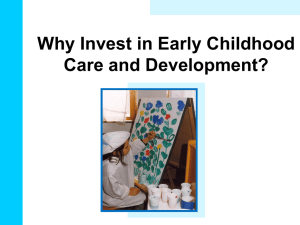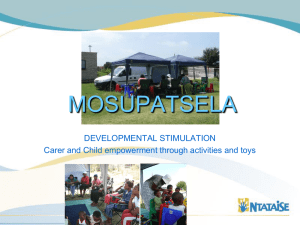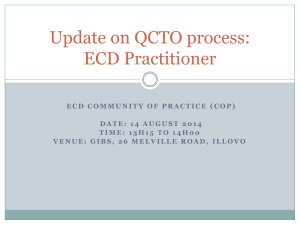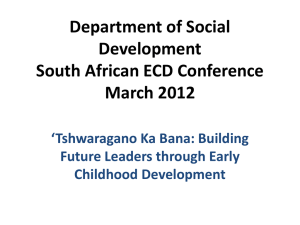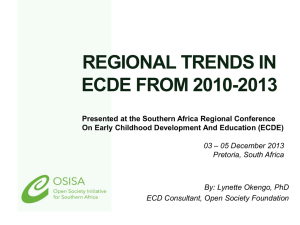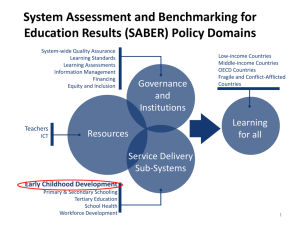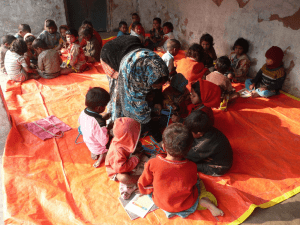Scaling up ECD (0
advertisement
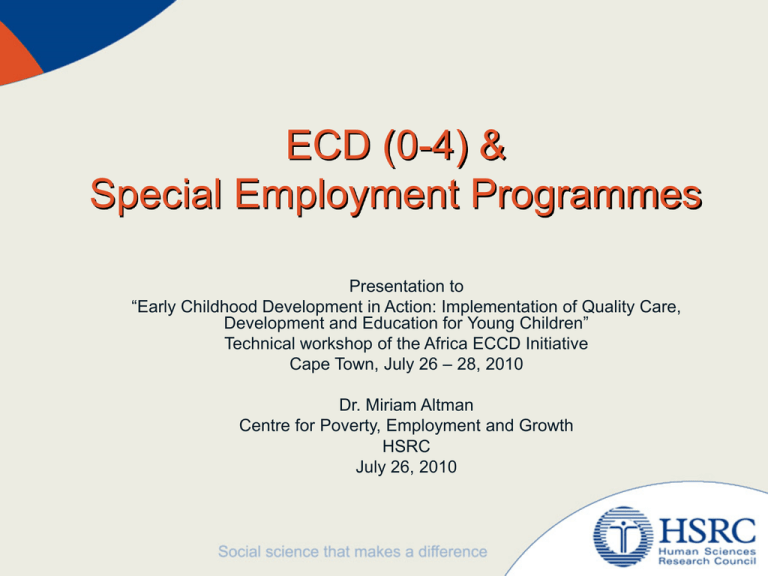
ECD (0-4) & Special Employment Programmes Presentation to “Early Childhood Development in Action: Implementation of Quality Care, Development and Education for Young Children” Technical workshop of the Africa ECCD Initiative Cape Town, July 26 – 28, 2010 Dr. Miriam Altman Centre for Poverty, Employment and Growth HSRC July 26, 2010 Background • Although SA is middle income country – now with strong state resources • High inequality, unemployment, and community marginalisation • Exclusion was policy goal. Social policies racially distinct • On entry to new govt, aid funding channelled through the state and community services weakened • Growing recognition of need to strengthen ECD support and commitment to rolling out Motivation • Identified service delivery gap in child development • Until early 2000s, early child development no-one’s responsibility • Child development indicators reflect this neglect • Recognition of role ECD services can play in improving child indicators • Enable children from poor families to start on similar footing to resourced families • Identified ECD (0-4) as extremely large potential employer. • Context of extremely high unemployment, especially amongst women • Potential to create up to 345,000 jobs, but at cost of about R 7 billion by 2009. (not incl ancilliary workers) SA service delivery targets • The National Integrated Plan for Early Childhood Development in SA 2005 – 2010 (2005) identified a critical challenge of reaching 2.6 million children by 2010: (50% of children 0-4 years) 16-20 % children to be reached through formal sites (e.g. creches, ECD centres etc) 30 % children to be reached through community based programmes (e.g. IMCI, Grants, PMTCT, playgroups etc.) 50 % children to be reached through services directly targeting the household (e.g. birth registration, protection, hygiene, psychosocial care and support etc.) What do we mean by Early Childhood Development (ECD) Services? • It goes beyond creches, day care centres and preschools. • It includes all services for children 0-4 years including health care, grants, nutrition, access social grants, mental development, social development • programmes such as child minding, home visiting, parent education, play projects, cognitive development and health programmes • ECD services are inherently delivered in networks What does scaling up ECD mean? Increase the numbers of children who are benefiting from ECD Increase the different types of services children 0-4 can get. Improve the quality and sustainability of ECD services Current scale of ECD (0-4) service delivery • On ECD, the statistics shows that: • 51% of children have some external supervision support • Approx ½ are with day mother or grandmother • In 2008, approx 1.3 m children (26% of the cohort age 0-4) are enrolled in ECD – Up from 8% in 2002 and 17% in 2006 • Very small % receive state support. Other sources of funding in poor communities very limited. Often depend on grant recipients. • On other programmes: • Wide coverage of a child support grant, although 0-2 still a challenge • Birth registration coverage was 25% in 1998 and 72% in 2005 • In 2006, 84% of children under one received primary vaccines • Vit A distribution, reaches 20% of target State support for ECD (0-4) • The government provides an subsidy to ECD centres through the provinces. • Delivered by non-profit organisations, who apply on a per-head basis • In 2007, 10% (approx 300,000) of poor children in a centre subsidised by the state • Substantial variation by province – eg eastern cape = 3% coverage, vs western cape = 23% ECD delivery through home community care • Home community care meant to be the main approach to delivery • Still not defined, and therefore difficult to support • Having done some investigation, we believe the service can be defined as a network • Locus of support is the service organisation that links households to services • This approach to delivery can especially make sense in reaching marginalised communities Challenge of state involvement • Scaling up using state resources adds a challenge • Care for vulnerable or ‘voiceless’ carries risk when done at scale • State is accountable • Lowest immediate risk approach for state is to let families do it themselves • However longer term risk of poor human development State & CBOs fundamentally different • State is large, lumbering bureaucracy that is understandably rule bound. • Interest is in a birds eye view of social delivery that needs to reach large numbers of people • Many CBOs are more precarious, and are not rule bound. • Interest is in delivering to the community around them • Reaching smaller numbers at any time, with more flexibility • Esp in ECD services, supporting institutions may not currently be strong enough to enable kind of scaling up sought – unlike many other sectors that are more formalised. Expansion and sustainability of employment • Human resources contribute the majority of the cost in ECD services, whether in centres or home community networks = about 70 to 90% of all costs • In SA, we have linked public works programmes to community based delivery of social services. • Dilemma = job creation for marginalised or job creation for service delivery? Potential approach to be tested • Public works(phase 2) (or EPWP II) introduced: • Employment Incentive • Subsidises continuous employment in non-profit organisations that can show employment expansion • Subsidy is valued at about R 1000 per month • Similar to earning of domestic worker or informal sector worker • Substantially more than what is currently earned in ECD and is stable. • Organisation can top-up if able to do so Community Works Programme working at ward level which guarantees 1-2 days work per week in activities defined by the community Matching opportunities • EPWP Employment Incentive funds stable employment • ECD subsidy through province funds inputs and service matching such as birth registration, immunisation, stimulation, nutrition, vitamin A, practitioner and parent skills development, etc. This must be defined so that funding can be made available. • National commitment to expanding further education and training enrolments, which is level of ECD training • Significant funding available in the National Skills Fund

